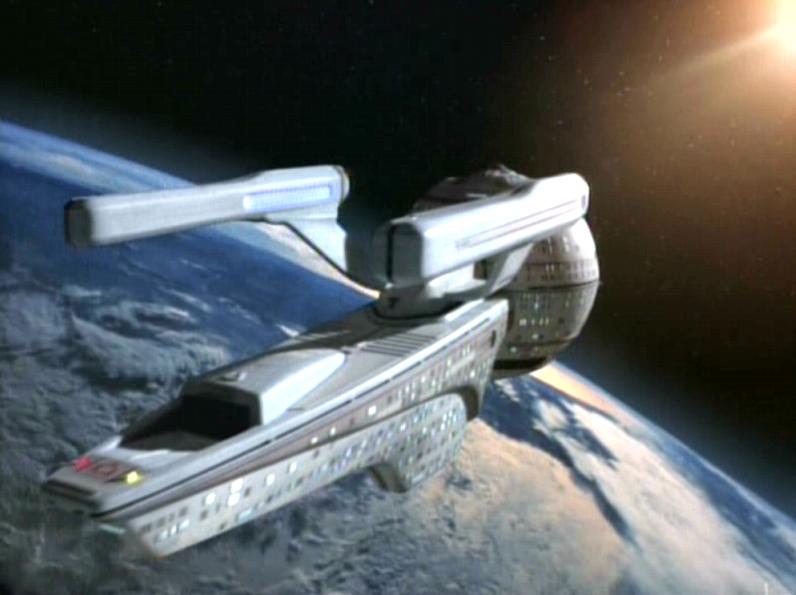The Olympic-Class Hospital Ship was developed from the DAVID ESTEP-Class REF Spacy Hospital Ships for the UGC late in the 23ʳᵈ century for use by private hospital services- Under contract with the | Olympic-Class Hospital Ship |
|---|
 |
|---|
Production Information |
|---|
| Original Manufacturer: | UGC. |
|---|
| Manufacturers: | Many Shipyards. |
|---|
| Type: | Hospital Ship. |
|---|
Technical Specifications: |
|---|
| Length: | 800 feet. |
|---|
| FTL Rating: | Class 8. |
|---|
| Shielding: | Civilian. |
|---|
| Hull: | Standard vacuum hull. |
|---|
| Sensor Systems: | Civilian-grade sensors. |
|---|
| Armament: | Point Defense Laser Turrets (10). |
|---|
| Complement: | - Repulsorlift vehicles (5)
- Shuttles (8).
|
|---|
| Crew: | 1,000. |
|---|
| Passengers: | 20,000 patients. |
|---|
| Cargo Capacity: | 9,000 metric tons. |
|---|
| Consumables: | 18 months. |
|---|
Usage: |
|---|
| Roles: | - Mobile Hospital
- Mobile School.
|
|---|
 | | An Olympic-Class over FBX 2155320. |
|---|
UGC (not the militry), the Olympic-Class was intended to augment REF Battle Fleets during times of war, mass-casualty emergency services, and other normal hospital ship duties; When not operating under the emergency services contract, the ships are free to ply their trade for profit. This provides the UGC over 2,000 additional hospital ships, with the majority of the cost transferred to the hospitals that actually own the ship.BackgroundIn 2372, the planet Gorrean suffered a mass meteor strike; About 80% of the planet was hit, and 100% of the cities was flattened. However, millions of Gorreans survived the meteor shower, and they had to be treated. Strike Force 18-04 and 18-05 (18ᵀᴴ Fleet) raced to the scene, but with only four hospital ships, even the the carog ships were being converted to casualty wards; It is estimated 8 million Gorreans died due to lack of medical care, caused by the overwhelming nature of the event.The Council decided that was NOT going to happen again. The Council, without authorization, put out a specification for a new class of vsl capable of serving as hospitals, but capable of being utilized by private medical service providers (hospitals, etc). The problem had always been economic: A hospital SHIP costs 10-22% more than standard (fixed, ground) hospitals. Even the most efficient designs were cost-prohibitive.Ulysses Naval Yards, the same firm that developed the DAVID ESTEP-Class Hospital Ships, proposed a variant of their flagship product, by building a huge "head" on the ESTEP-Class to hold the medical wing. The increase of casualty capabilities combined with the set cost of the ships just barely broke the cost/benefit barrier, and combined with a Council grant (also without authorization) to subsidize construction made the new ships just profitable enough to make it worht the risk (keep in mind, hospitals have bills to pay as well).Using Merchant Marine Guild crews for ship's operations and Hospital Professionals for medical duties, the ships are able to maintain the needed cost/benifit balance to allow them stay in service; Under UGC Law, the ships must maintain 600 underway hours yearly to keep their certification, so the ships typically make a monthly "humanitarian cruise" yearly, with between 1 and 5 doctors (usually from multiple hospitals) within the home star system. This gives them the hours needed (just over 700), and the cost of the cruise can be taken off from their yearly taxes (hospitals do make a profit), which makes for a double-win deal- The doctors get field experience time (helpful in keeping their minds fresh), the ship gets her certification, the hospital gets to cut their tax burden, poorer sectors of the system get medical assistance, and everyone looks good in the process (even the UGC cashes in on this, since everyone knows they ponied up the starter money).The Council did not have the authorization to grant any money to anyone for this program; However, the popularity of the program caused the Safety And Health Services to ex post facto support the program (SAHS should have had the program first), and the Chairman signed the bill- Without reading it. (It had, in fact, been Chairman HORITH who originally proposed the program anyways, so she didn't have a reason to oppose it- Had she noticed the several dozen riders slipped in there, she might have thought otherwise.)DesignDesigned primarily for medical emergencies, the Olympic-Class features a spherical "head" where most of the hospital services are located. The Olympic-Class had at least two dozen surgical rooms, plus a trauma ward capable of handling up to 100 casualties at the same time- Essentially 100 surgeries can be preformed, though mostly of the "meatball" variety under mass-casualty conditions. (Fortunately, 99% of the time the ships are engaging in routine medical duties, and therefore the "100 surgeries an hour" ability becomes "100 consultations a day", with patients sitting around waiting for the doctors.) Additionally, the Olympic-Class can serve as valuable teaching facilities, giving future doctors hands-on opportunities not only in emergency medicine, but also xenobiology (the study of life forms other than their own type, for example a Fljyt can study T'sentraedi biology), which is critical to the would-be doctors to be able to treat anyone, anywhere, at any time. The need to study xenobiology is, in fact, critical, even to a doctor who has no intention of leaving their native world, since a Fehran (very similar to Terran, T'sentraedi, Fljyt, and most other humanoids, though not identical) might wind up on say Isengard and be in need of treatment. If a Saurian doctor can not tell which organ is the heart and which is the liver (a real possibility, given that Fehran's livers and hearts are close together, though colored differently), the Fehran might well die. Under the Galactic Medical Code, this could result in loss of license if 'only' incompetent, or even imprisonment if it determined to be more than that.Becasue of the breadth of species in the UGC, every hospital is equipped with full Species Biological Information Library, including known allergenic reaction (a Firse Fljyt, for example, will DIE if sprayed with pepperspray, while an Uruk-Hai will not feel anything for three days, then develop a minor itchy rash, whereas a T'sentraedi will never feel anything). However, these libraries are not 'always' available, and doctors must at least be able to identify the parts in the big picture, in order to decide WHICH rupture is most critical to suture first.Design And LayoutThe Olympic-Class Hospital Ships are small and sleek vessel, with a huge Red Cross on her sides and underside. They are the only vls with the "Spacebird" configuration of two engine nacelles separated from a main hull, and a secondary hull area (the spherical forward area); The separate nacelles are part of the ESTEP-Class as well as a few others, but not the forward secondary hull.Noteworthy Ships of the ClassPasteur is particularly famous for being the only hospital ship to date to actively engage an enemy, both receiving and returning fire, and, more so, for AGGRESSIVELY PROSECUTING THE ENGAGEMENT; During the Battle of Neuvous 2883412, she was attacked by a pair of malcontent Klinton-Class Cruisers. Her captain at the time could easily have run away, but chose instead to stand and fight, and was not only not censured for her decision, but commended; She was waiting for shuttles from the surface to arrive with wounded soldiers and Marines. Cap't CRUSHER-PICARD believed, incorrectly as it would turn out, that the shuttles were still enr, and chose to stand fast for their recovery. (Her decision to chase the enemy battlewagons is a controversy that remains to this day, but during the closed Board of Inquiry apparently convinced the Board her decision was correct.) Fortunately, the RIKER (BREETIA TULL-Class UDF-21001) was able to come to her rescue, destroying both the cruisers and their fighters (RIKER'S skipper did testify during the BOI, and this may have had an influence on the outcome).Fleet DeactivationIn 2487, a to-date unexplained defect in the Olympic-Class's space fold drives led to the fleet being deactivated, then their spacefold drives replaced. During this time the ESTEP-Class were reactivated and upgraded, making the Olympic-Class redundant. Rather than scrap the fleet out, they were sold to private parties where they remain now.
Name: Olympic-Class.
Vsl Type: Hospital Ships.
Crew: About 1,000.
Passengers: Up to 20,000 patients.
MDC By Location: |
| Video Recorder: Records from sensors and the cockpit itself. 500 hours of recording available. Radar: Civilian grade radar. Range: 20,000 miles, can track up to 250+/- individual targets. 95% reliability (00% against stealthed vehicles). FLIR/SLIR: Forward and Side Looking Infrared. Allows pilot and weapons officer to get visuals on targets at night. ESM: Radar Detector. Passively detects other radars being operated. AJP: Active Jamming Pod. Causes -25% to detection but when it is active, other vehicles/bases can detect that it is jamming, and some missiles will home in on jamming signals. Jamming also causes a -4 penalty to all radar guided weapons. Full Range Sensory Suite: Infrared, ultra violet, Magnification, night sight, color filters, thermal imager. Range is about 2,000 miles for MOST sensors. Motion Detector: Activates a loud wailing when an object is coming at the user fast, and a soft ringing if it's coming slowly. Activation ranges must be specified by the pilot. Electronic Counter Measures (ECM): These systems disrupt enemy radar and tracking systems, making it difficult for them to lock onto the ship with weapons. The countermeasures give the Mecha a +3 to dodge, +2 to strike and +1 on initiative in combat. Fire resistance: Fires external to the craft have no effect on it. | Grav Clamps: Electro magnets in the underside of the hull allow the unit to adhere to the hulls of warships and the exteriors space sations and ships. Type-11 wide band radios: Effective 10 mile range, auto encrypt/decrypt. Works on standard radio band wavelengths, so it can still be jammed (if the enemy knows the frequencies). Decoy Pods: The Steneirian style decoy pods were installed on the ships for self-defense. The decoys themselves are specially modified Mini-Missiles that produce burning globs of magnesium/aluminum alloy to confuse both radar AND heat sensory systems, obscuring the ship. NOTE: Reduce effects by 20% against smart missiles (add +20% to rolls for smart missiles.)Effect:01-50: Enemy missile or missile volley detonates in chaff cloud - Missiles are all destroyed.51-75: Enemy missile or missile volley loses track of real target and veers away in wrong direction (may lock onto another target).76-00: No effect, missile is still on target.Also note that the chaff cloud will also blind nearby heat sensors (and optically based sensors at night) for 1 melee. They will suffer the following penalties: Reduce melee attacks/actions, and combat bonuses by half. Also, a cloud of smoke approximately 252 feet.Duration: 1D4 melee rounds.Rate of Fire: Once per melee.Payload: 6 chaff/flares. |